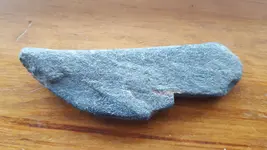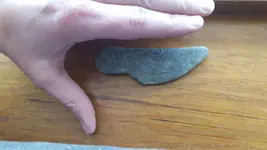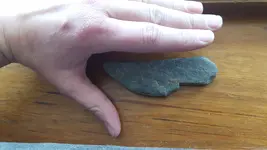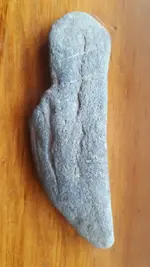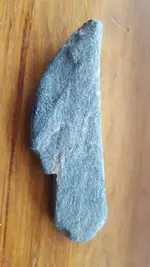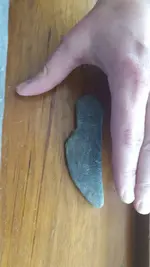You are using an out of date browser. It may not display this or other websites correctly.
You should upgrade or use an alternative browser.
You should upgrade or use an alternative browser.
Possible stone tool or weapon?
- Thread starter Gtiguy113
- Start date
DCMatt
Gold Member
- Joined
- Oct 12, 2006
- Messages
- 10,472
- Reaction score
- 13,785
- Golden Thread
- 0
- Location
- Herndon Virginia
- Detector(s) used
- Minelab Equinox 600, EX II, & Musketeer, White's Classic
- Primary Interest:
- Metal Detecting
Welcome to the forum!
I suggest you post your item here:
North American Indian Artifacts
Good luck!
DCMatt
I suggest you post your item here:
North American Indian Artifacts
Good luck!
DCMatt
Upvote
0
DARKCYDE
Jr. Member
- Joined
- Aug 25, 2014
- Messages
- 53
- Reaction score
- 29
- Golden Thread
- 0
- Location
- Fostoria, Ohio
- Detector(s) used
- Quick Draw II
- Primary Interest:
- All Treasure Hunting
I can't see any tool marks to suggest it has been worked. I get cool rocks all the time that look like they might be something, but I've learned nature can do strange things with stones.
Upvote
0
Indian Steve
Silver Member
It has the shape of a modern knife but shows no flaking or grinding that would indicate being made by man. Still a cool rock. I would have picked it up.
Upvote
0
- Joined
- Jan 27, 2009
- Messages
- 18,870
- Reaction score
- 12,114
- Golden Thread
- 1
- Location
- South East Tennessee on Ga, Ala line
- 🥇 Banner finds
- 1
- Detector(s) used
- Tesoro Conquistador freq shift
Fisher F75
Garrett AT-Pro
Garet carrot
Neodymium magnets
5' Probe
- Primary Interest:
- All Treasure Hunting
Do keep looking. Find the flint flakes and the rest will follow. Welcome to T-Net!
Upvote
0
mcl
Sr. Member
Just wondering, how can you tell?
Most of the genuine, real-deal Native American tool/weapon finds on here are going to be flaked from rocks like chert and flint. For those, you can tell whether or not it is real by looking for signs of deliberate flaking (i.e., on both sides of an edge/face). These tend to look jagged.
Now your find is made from a different sort of stone altogether. Most of the time when Native Americans made tools from those type of stones, it involved a long, laborious, and methodical process of rubbing the rock back and forth on wet sand and/or other rocks in order to gradually create the desired shape. As a result, these tools very often have a polished, contoured, symmetrical, and deliberate shape which is difficult to miss; they also are very often hafted (i.e., have a groove for affixing the tool to a handle, such as a celt, axe, or hammer). They look very different from flaked artifacts but are nonetheless distinct in appearance. Here are a few examples:
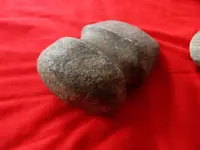
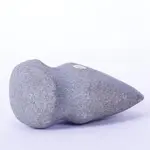
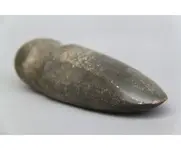
Note how every single facet, contour, face and edge of those artifacts are unmistakably the result of laborious, deliberate grinding that have smoothed and polished the surfaces into the intended shapes.
Now compare this to the object you found. Notice how the thinner, perhaps "handle" portion has a sharp corner where it meets the "blade"? It is very clear that this feature is the result of fracturing, not slow and continuous grinding. That means that at least that part was not "manmade". Now look at the other surfaces of your piece and note how there is evidence of breakage on almost all faces of the rock; it now becomes clear that all of the features which previously made it look like a manmade artifact are actually the result of natural weathering/decay.
I hope this helps to answer your question. Welcome to T-Net.
-mcl
Upvote
0
- Joined
- Jan 27, 2009
- Messages
- 18,870
- Reaction score
- 12,114
- Golden Thread
- 1
- Location
- South East Tennessee on Ga, Ala line
- 🥇 Banner finds
- 1
- Detector(s) used
- Tesoro Conquistador freq shift
Fisher F75
Garrett AT-Pro
Garet carrot
Neodymium magnets
5' Probe
- Primary Interest:
- All Treasure Hunting
Most of the genuine, real-deal Native American tool/weapon finds on here are going to be flaked from rocks like chert and flint. For those, you can tell whether or not it is real by looking for signs of deliberate flaking (i.e., on both sides of an edge/face). These tend to look jagged.
Now your find is made from a different sort of stone altogether. Most of the time when Native Americans made tools from those type of stones, it involved a long, laborious, and methodical process of rubbing the rock back and forth on wet sand and/or other rocks in order to gradually create the desired shape. As a result, these tools very often have a polished, contoured, symmetrical, and deliberate shape which is difficult to miss; they also are very often hafted (i.e., have a groove for affixing the tool to a handle, such as a celt, axe, or hammer). They look very different from flaked artifacts but are nonetheless distinct in appearance. Here are a few examples:
View attachment 1392480
View attachment 1392481
View attachment 1392482
Note how every single facet, contour, face and edge of those artifacts are unmistakably the result of laborious, deliberate grinding that have smoothed and polished the surfaces into the intended shapes.
Now compare this to the object you found. Notice how the thinner, perhaps "handle" portion has a sharp corner where it meets the "blade"? It is very clear that this feature is the result of fracturing, not slow and continuous grinding. That means that at least that part was not "manmade". Now look at the other surfaces of your piece and note how there is evidence of breakage on almost all faces of the rock; it now becomes clear that all of the features which previously made it look like a manmade artifact are actually the result of natural weathering/decay.
I hope this helps to answer your question. Welcome to T-Net.
-mcl
Very nice well thought out post. Thanks for taking the time and sharing your experience/knowledge.
Upvote
0
Similar threads
- Replies
- 11
- Views
- 876
Users who are viewing this thread
Total: 1 (members: 0, guests: 1)

